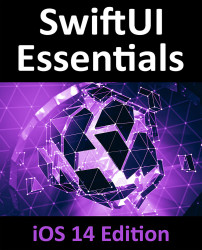Playgrounds are particularly useful when working and experimenting with Swift algorithms. This can be useful when combined with the Quick Look feature. Remaining within the playground editor, enter the following lines of code beneath the existing print statement:
var x = 10
for index in 1...20 {
let y = index * x
x -= 1
print(y)
}
This expression repeats a loop 20 times, performing arithmetic expressions on each iteration of the loop. Once the code has been entered into the editor, click on the run button positioned at line 13 to execute these new lines of code. The playground will execute the loop and display in the results panel the number of times the loop was performed. More interesting information, however, may be obtained by hovering the mouse pointer over the results line so that two additional buttons appear as shown in Figure 4-9:
...



